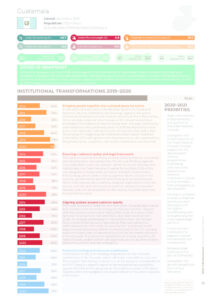Nutrition situation
Under five stunting (%)
46.7
Under five overweight (%)
4.9
Anaemia in women 15-49 years (%)
16.4
Under five wasting (%)
0.8
Low birth weight (%)
11
0 to 5-month-old exclusive breastfeeding (%)
53.2
Adolescent overweight (%)
Male: 24.6
/ Female: 29.6
Adult overweight (%)
Male: 51.4
/ Female: 59.9
Adult obesity (%)
Male: 15.1
/ Female: 26.4
Adult diabetes (%)
Male: 8.9
/ Female: 10.4
COVID-19 snapshot
Within the framework of the COVID-19 emergency, the Government of Guatemala implemented actions that were necessary to support the vulnerable population: Emergency Law to protect Guatemalans from the effects; Rescue Law; actions to actively search for cases of acute undernutrition; Ministerial Accord on the School Feeding Programme. A total of 320 Emergency Operations Centres were activated.
Institutional transformations 2019-2020
Bringing people together into a shared space for action
At the national level, there is the National System for Food and Nutrition Security (SINASAN), which brings together the actors involved in ensuring food and nutrition security (FNS) in the country. There are departmental commissions at the departmental level, municipal commissions at the municipal level, and even community commissions at the community level. In 2019 the Protocol on Joint Action was approved, with procedures for coordination and action. The process of integrating the Interinstitutional Liaison Technical Committee (CTI) with government representatives, aid organisations, the private sector, academia, civil society and donors was resumed.Ensuring a coherent policy and legal framework
The General Government Policy and the National Plan for Innovation and Development were presented. The Annual Working Agenda was established under the Special Cabinet on Social Development. Additionally, the Great National Crusade for Nutrition 2020–2024 was designed and approved, as well as President Giammattei’s FNS strategy, which seeks to bring together all the sectors in the country: governmental (central and municipal), private business, NGOs, international aid, academia, religious organisations and civil society, with the goal of improving nutrition among Guatemalan families, and with an emphasis on the country’s poorest and most marginalised people.Aligning actions around common results
The Great National Crusade for Nutrition (Gran Cruzada Nacional por la Nutrición) is the national strategy to improve nutrition, aligned with the General Government Policy 2020–2024, the K’atun 2032 National Development Plan and the Sustainable Development Goals. An analysis and linkage of interventions from the Annual Food and Nutrition Security Operational Plan was carried out, with interventions from each course of action, coordinated with departmental governors. Within the framework of the CTI, working subcommittees were incorporated to promote the implementation of the Crusade. The document guidelines for actively searching for cases of acute undernutrition was approved, as well as other actions related to nutrition and the emergency.Financial tracking and resource mobilisation
Participation in the joint funding programme for the financial architecture of the Crusade, which will make it possible to carry out the Crusade. Monitoring is carried out on the progress of expenditure on FNS. There is a specific report in the integrated accountability system (SICOIN) on the progress on the implementation of financial targets within the budgetary structures linked to FNS, and it is public information.2020-2021 Priorities
- Align interventions implemented by the platform in the Great National Crusade.
- Strengthen the implementation of the Great National Crusade through support for the development of plans, programmes, monitoring and evaluation, research and resource mobilisation, based on the transition from emergency to development.
- Develop a workplan in order to improve communication strategies with the goal of consolidating and strengthening the multi-stakeholder platform.
- Foster resource mobilisation to support national humanitarian aid mechanisms.
- Increase social auditing on the part of civil society.
- Strengthen the gender perspective and cultural relevance.
Download

